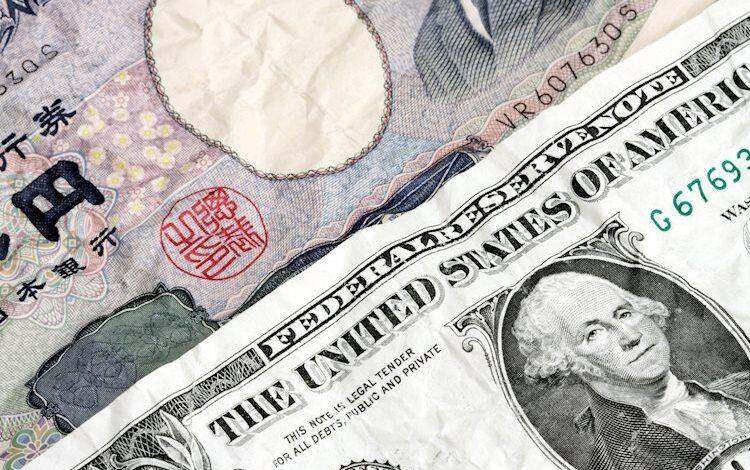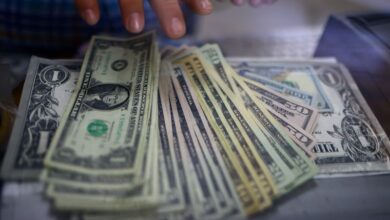Japanese Yen trims a part of intraday gains against USD amid reduced Fed rate cut bets

- The Japanese Yen gains positive traction and reverses a part of Wednesday’s post-US CPI slump.
- Intervention fears, along with a weaker risk tone, underpin the JPY and exert pressure on USD/JPY.
- The divergent Fed-BoJ policy expectations help limit any meaningful corrective slide for the pair.
The Japanese Yen (JPY) attracts some buyers on Thursday and reverses a part of the previous day’s heavy losses to a fresh multi-decade low touched against its American counterpart in the aftermath of hotter US consumer inflation figures. Investors remain on alert in the wake of the possibility of an intervention by Japanese authorities to support the domestic currency, Apart from this, a generally weaker tone around the equity markets turns out to be a key factor boosting demand for the safe-haven JPY.
Meanwhile, the crucial US CPI report forced investors to push back their expectations about the timing of the first interest rate cut by the Federal Reserve (Fed) to September from June. Moreover, minutes of the last FOMC meeting indicated that officials were worried that the progress on inflation slowed, and they may have to keep rates higher for longer. In contrast, the Bank of Japan (BoJ) had signalled that monetary policy will remain easy for some time, suggesting that the US-Japan rate differential will stay wide.
Furthermore, hawkish Fed expectations keep the US Treasury bond yields elevated and act as a tailwind for the US Dollar (USD). This, in turn, assists the USD/JPY pair to attract some dip-buying and bounce back to the 153.00 mark heading into the European session. Traders now look to the US economic docket – featuring the release of the usual Weekly Initial Jobless Claims and the Producer Price Index (PPI). Apart from this, speeches by influential FOMC members will drive the USD and provide some impetus.
Daily Digest Market Movers: Japanese Yen struggles to capitalize on modest intraday gains amid divergent Fed-BoJ policy expectations
- The US Dollar surged across the board in reaction to the third straight month of strong US consumer price readings, dragging the Japanese Yen to its lowest level since mid-1990 on Wednesday.
- The US Bureau of Labor Statistics (BLS) reported that the headline Consumer Price Index (CPI) rose by the 3.5% YoY rate in March compared to the 3.4% anticipated and 3.2% in the previous month.
- Meanwhile, the annual core CPI, which excludes volatile food and energy prices, held steady at 3.8%, while on a monthly basis, the CPI and the core CPI both rose 0.4% as against the 0.3% estimated.
- This follows last week’s upbeat US jobs data for March and fueled speculations that the Federal Reserve would delay cutting rates, triggering a surge in the US Treasury yields and the US Dollar.
- The FOMC meeting minutes showed concerns over stalling inflation progress, pushing the yield on the two-year and the 10-year US government bonds to their highest level since last November.
- Japanese government officials continued with their jawboning to defend the domestic currency, which, in turn, provides some respite to the Japanese Yen and exerts pressure on the USD/JPY pair.
- Japan’s top currency diplomat, Masato Kanda, reiterated that he won’t rule out any steps to respond to disorderly FX moves and that he is prepared to take necessary actions whenever possible.
- Finance Minister Shunichi Suzuki also offered some verbal intervention, saying that excessive FX moves are undesirable and that he is in constant discussion with Vice Finance Minister Kanda on FX.
- Japan’s Chief Cabinet Secretary Yishimasa Hayashi said that it is important for currencies to move in stable manner reflecting fundamentals and that he won’t rule out any steps to respond to excessive FX moves.
- Ceasefire talks between Israel and Hamas have yielded no agreement, which, along with a possible Iranian retaliation over a suspected Israeli strike on its embassy in Syria, drive some haven flows towards the JPY.
- The Bank of Japan struck a dovish tone at the end of the March meeting and stopped short of offering any guidance about future steps, which should keep a lid on any further gains for the JPY.
- Thursday’s US economic docket features the release of the usual Weekly Initial Jobless Claims and the Producer Price Index (PPI) for March, followed by speeches by influential FOMC members.
Technical Analysis: USD/JPY bulls not ready to give up yet, short-term trading range breakout remains in play
From a technical perspective, the downtick could be attributed to some profit-taking amid overbought conditions on hourly charts. Any subsequent slide, however, is likely to stall near the 23.6% Fibonacci retracement level of the recent rally from the 150.80 area, or the monthly low touched last Friday. Some follow-through selling below the said support, around the 152.65 region, could drag the USD/JPY pair to the 152.30 zone, or the 38.2% Fibo. level, en route to the 152.00 mark. The latter represents a short-term trading range breakout point and should act as a strong near-term base for spot prices.
On the flip side, the 153.00 round figure might now offer some resistance ahead of the multi-decade peak, around the 153.25 region. A sustained strength beyond will be seen as a fresh trigger for bullish traders and set the stage for an extension of the USD/JPY pair’s recent uptrend witnessed over the past month or so.
Fed FAQs
Monetary policy in the US is shaped by the Federal Reserve (Fed). The Fed has two mandates: to achieve price stability and foster full employment. Its primary tool to achieve these goals is by adjusting interest rates. When prices are rising too quickly and inflation is above the Fed’s 2% target, it raises interest rates, increasing borrowing costs throughout the economy. This results in a stronger US Dollar (USD) as it makes the US a more attractive place for international investors to park their money. When inflation falls below 2% or the Unemployment Rate is too high, the Fed may lower interest rates to encourage borrowing, which weighs on the Greenback.
The Federal Reserve (Fed) holds eight policy meetings a year, where the Federal Open Market Committee (FOMC) assesses economic conditions and makes monetary policy decisions. The FOMC is attended by twelve Fed officials – the seven members of the Board of Governors, the president of the Federal Reserve Bank of New York, and four of the remaining eleven regional Reserve Bank presidents, who serve one-year terms on a rotating basis.
In extreme situations, the Federal Reserve may resort to a policy named Quantitative Easing (QE). QE is the process by which the Fed substantially increases the flow of credit in a stuck financial system. It is a non-standard policy measure used during crises or when inflation is extremely low. It was the Fed’s weapon of choice during the Great Financial Crisis in 2008. It involves the Fed printing more Dollars and using them to buy high grade bonds from financial institutions. QE usually weakens the US Dollar.
Quantitative tightening (QT) is the reverse process of QE, whereby the Federal Reserve stops buying bonds from financial institutions and does not reinvest the principal from the bonds it holds maturing, to purchase new bonds. It is usually positive for the value of the US Dollar.
Information on these pages contains forward-looking statements that involve risks and uncertainties. Markets and instruments profiled on this page are for informational purposes only and should not in any way come across as a recommendation to buy or sell in these assets. You should do your own thorough research before making any investment decisions. FXStreet does not in any way guarantee that this information is free from mistakes, errors, or material misstatements. It also does not guarantee that this information is of a timely nature. Investing in Open Markets involves a great deal of risk, including the loss of all or a portion of your investment, as well as emotional distress. All risks, losses and costs associated with investing, including total loss of principal, are your responsibility. The views and opinions expressed in this article are those of the authors and do not necessarily reflect the official policy or position of FXStreet nor its advertisers. The author will not be held responsible for information that is found at the end of links posted on this page.
If not otherwise explicitly mentioned in the body of the article, at the time of writing, the author has no position in any stock mentioned in this article and no business relationship with any company mentioned. The author has not received compensation for writing this article, other than from FXStreet.
FXStreet and the author do not provide personalized recommendations. The author makes no representations as to the accuracy, completeness, or suitability of this information. FXStreet and the author will not be liable for any errors, omissions or any losses, injuries or damages arising from this information and its display or use. Errors and omissions excepted.
The author and FXStreet are not registered investment advisors and nothing in this article is intended to be investment advice.



